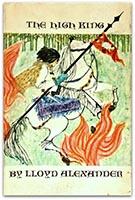As Gandalf reminded us, the New Year in Gondor shall always begin on the 25th of March; and here we are. But I have not been reading Tolkien recently, though I have been somewhat immersed in the work of one of his epigones – as I shall discuss below.
What I have been reading is From First to Last, by Damon Runyon, who wrote what silly people call ‘realistic’ or ‘mainstream’ fiction, but was really in the fine old tradition of the American tall tale. And my Beloved Bride and I have been watching The Witcher, based on the stories of Andrzej Sapkowski. And this experience, I find, gives the lie to the old canard that ‘worldbuilding’ is the particular province of science fiction and fantasy writers. For Runyon built a world, and a very colourful and recognizable world at that, founded in the gangster-ridden New York of the 1920s and 30s, but lovingly worked up into an imaginary and imaginative place all its own. Whereas Sapkowski’s worldbuilding is paper-thin, and the quality of his world seems to rely far more on the genre expectations of his readers or viewers than on his own imaginative powers.
I will say, however, that Sapkowski does a lively trade in Slavic mythology, and particularly in the wonderfully weird monsters that the Slavs are so good at inventing; and this contributes a great deal to the charm and interest of his work. Whereas the only monsters Runyon ever dealt in were gangsters and bootleggers, and maybe the occasional racehorse. Obviously these two authors cater to very different tastes; but of the two, I find that I have the more to learn from Runyon, because he has very few equals in the difficult art of using the language of his narration and dialogue to build up his world in the reader’s mind.
Whereas Sapkowski’s translators employ a style so pedestrian it actually makes me wince at times, and whatever merits he may have as a stylist, they fail to come across in the English version. What’s worse, the screenwriters for the TV adaptation have no idea how to tell a story straight, and mix together timelines across a span of fifty years or more without ever troubling to tell the viewer if t’other comes before which, or after which, or during which. This is less troubling to the sort of viewer who just wants to be swept along by sex and violence and good rollicking action, and doesn’t give a damn whether he can understand it or not. But there are websites and supporting videos and all manner of aids designed specifically to help people understand the storyline of The Witcher, which shows that there are a great many of the other kind of viewers, who do care and want to understand, and cannot make head or tail of the story without external help. This is a very grave fault.
I hope I shall have more to say about both these writers and their interesting works in the near future. But meanwhile I am beset with troubles, for my Beloved Bride is battling an injury, and a dear friend of mine has just lost her husband, and I am spending more time than I could wish helping them both cope with the practicalities of the situation. Life has set in with unusual severity, and for the moment, there is no time for stories.










Recent Comments